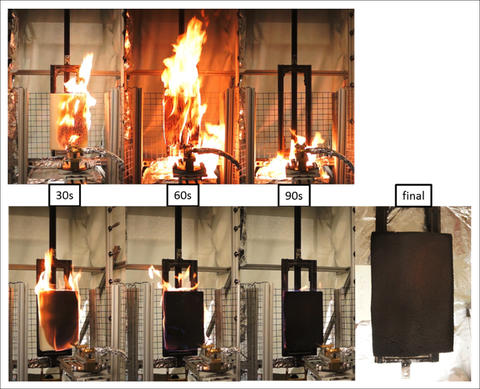
Open-flame tests compare the flammability of untreated polyurethane foam (top) and an identical foam sample surface treated with a sandwich-like coating incorporating layered double hydroxides. By 90 seconds after ignition the untreated foam is completely consumed. The experimental flame retardant formed a protective residue that caused the size of the flames to decrease and then to extinguish.
In a face-off between two promising flame retardants, the challenger—a nanomaterial that maintains a positive façade while sheltering a negative interior—outperformed its chemical antithesis. And that material already is a leading candidate for environmentally friendly fire-resistant coatings on furniture foam.
Gram for gram, sandwich-like coatings with a so-called layered-double-hydroxide (LDH) center reduce the flammability of polyurethane foam more than comparable surface treatments with montmorillonite clay, report fire prevention researchers at the National Institute of Standards and Technology (NIST). Montmorillonite clay already is considered a promising, environmentally friendly replacement for older flame retardants, but LDH-based coatings can be applied in smaller amounts, resulting in fewer fabrication steps, according to the NIST team.
Both coatings are about twice as effective in blocking fire in polyurethane foam than current commercial flame retardants, several of which have been linked to human health risks and environmental problems. Polyurethane foam, which is extremely flammable, is the primary cushioning material used in furniture and other soft furnishings. Upholstered-furniture fires cause the largest number of household fire deaths and injuries, according to the National Fire Protection Association.
Discovered in 1942, naturally occurring LDH materials—and, more recently, their synthetic counterparts—are being eyed for a variety of uses, including controlled drug release, anticancer therapies and catalysis. These potential applications would exploit the same chemical structure that appears to make LDH materials good flame suppressants.
With a molecular structure of two positively charged outer layers that cloak a negatively charged middle, LDH forms a protective char layer when exposed to fire. Montmorillonite clay acts much the same, but has the opposite arrangement of electric charges. The LDH configuration confers two apparent advantages, the scientists say. First, LDH releases water at high temperatures, which dilutes the underlying foam. Second, LDH's outer layers absorb heat as they breakdown, which reduces the temperature of the foam.
As in their previous research on experimental flame retardants, the NIST team inserted the competing nanomaterials between layers of common polymers to create a three-layer arrangement. They then pile the trilayers one on top of another, creating stacks one to five trilayers high. In the case of LDH, layer-by-layer assembly resulted in uniform distribution of the material, which has been difficult to achieve with other methods.
In benchtop open-flame tests, the scientists found that two stacks of trilayers containing LDH provided the best protection. Compared with untreated polyurethane foam, the double-decker arrangement reduced peak heat release by 41 percent and average heat release by 79 percent, performing slightly better than triple-decker stacks of trilayers containing montmorillonite clay.
Although the two types of coatings performed similarly, "the LDH was at least 60 percent lighter and 50 percent faster to fabricate than the best montmorillonite clay coating," the researchers write.
If maximum flammability reduction is desired, the researchers recommend considering another experimental formulation they have tested: a bio-based coating that incorporates DNA, chitosan (a material in crab and shrimp shells), and montmorillonite clay. (See "All-Natural Mixture Yields Promising Fire Retardant.") However, combinations of these ingredients must be stacked 20 layers high to achieve optimal performance.
YC Li, YH Yang, J.R. Shields and R.D. Davis. Layered double hydroxide-based fire resistant coatings for flexible polyurethane foam. Polymer. In press, 2014. http://dx.doi.org/10.1016/j.polymer.2014.11.023.

